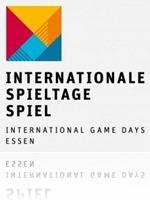One more year, we have taken the camera equipment and gone to Germany to what is *the* gaming event of the year for tens of thousands of people and thousands of companies. Once again, we battled the gigantic crowds of so many thousands, that finding out how many is as difficult as it’s unnecessary. They are, once again, a reflection of the increasing expansion of the gaming industry throughout the globe.
I am not going to compare Spiel with GenCon and, quite frankly, I don’t care how many more people GenCon had than Spiel. I only care that it’s good news for everyone, so if you’re expecting an article where I try to defend Spiel as the best gaming show, you might as well stop reading now.
There are many things about Spiel 2013 that are worth mentioning and have improved the show.
Firstly, the layout of the Messe, the place of events where the exhibition takes place, has changed considerably. From 12 smaller halls, the number of halls has been reduced to three, larger ones. Far from reducing the floor space, there was this year a great deal more space than previous editions of this trade show. Even on Saturday, the day families visit the show as children are not in school, walking from one place to another was easier. Less people bottlenecks between halls helped considerably. More food points throughout also helped spread people in need of a bite to eat or a drink.
Granted, the sorting order of the booths was strange to say the least and sometimes that made it very difficult to find the stands we were looking for. Although it wasn’t critical for us, it stressed us out a couple of times when we were a bit late from one interview to another.
Also I heard of at least one company that suffered from malfunction of some of the air-conditioning system and the organisation pretty much said there was nothing they could do to help. It sounded like rather bad customer service at the time, but I don’t have all the details, so I’ll reserve judgement on that one.
For the companies investing their euros in the booths, a smaller number of halls brought another added advantage; a more heterogeneous mix of companies.
In the past, big names like Hasbro, Pegasus Spiele, Days of Wonder, Asmodee, Schmidt and others were in just one or two halls, attracting a huge number of people because of the weight of their names. This year you could be very close to Haba, Queens Games and many others even if you were a small booth with tiny games. The passing trade increased phenomenally and, if the stands were attractive enough, they had a better chance to make business.
Something else I found is the gap between visually Great Booths, Average Booths and Poor Booths is widening. And that is very important for the traders.
The growth of the industry is creating ever-increasing competition for the number of visitors. More and more games are coming out, more game companies from the Far East and the USA are catching a plane to make it to the show, and they all have the same length of time to sell as many games as possible.
As a visitor, who would you stop by first, a visually interesting booth that promises great games, or a half baked one that hardly tells you anything about the game itself?
I know which ones attracted me!
Did the visually stunning booths deliver on what their visuals promised? Not always.
Did I find some gems in the uglier booths? Yes. But then, I am not a one-day-only visitor with my children. I am a journo and fairly hard-core gamer specifically looking for those gems.
And still I missed a lot of them. Even the morning after the show, I have heard of games I didn’t see. Why? Because I got attracted by another, better looking booth nearby.
If Spiel is *that big* that someone in a quest to find some hidden gems can’t find them, imagine what’s like for a couple with two kids who are there just to find a game or two for the family. I tell you what’s like: It’s like Hasbro, Days of Wonder, Asmodee, Mayfair, Schmidt, Haba and others of that size. That’s where they stop because that’s what they know and unless you have something else to catch their interest, that’s where they’ll go.
Then you get people who know what’s like and do as best they can to shine. Some do it very well, like Stronghold Games, who, partly because they have a terrific range of games, partly because they had a lot of tables and partly because they’re extremely approachable and found some volunteers who were committed to the public, had constant crowds in and sold out of a lot of games.
There are a lot more like them, and will happily provide with some examples if anyone is interested, but I think Stronghold is the company to follow as an example because they come from afar and have stricken a great balance between money spent in the show, number of games and quality of their stand.
Then there are the not-so-great booths. People with no banners to show the name of their games, without any sort of visuals other than the piled boxes of stock they’re hoping to shift to distributors or sell to passers by. Companies with very little to show, some with barely anything to show. Companies sharing their stands with so many other companies that one didn’t know when one game ended and another game begun.
Words of warning to those companies: You’re hurting yourself, and you’re hurting the hobby.
And then an example to follow for all of those small companies sharing too small space: Artic Union.
I have been a *massive* fan of this organisation since I learned about them three years ago. They come from Northern Europe and they are a cooperative of seven to ten small publishers who join forces to get a bigger stand with space for everyone to shine equally. You can see them from a distance and, once you get close, you can see all their games and the respective publishers will gladly show you what they have to offer. They all have the same sitting space. They all have the same opportunity to display everything. The difference is that they use each other strengths to compete with the bigger ones. If you don’t know them, strongly recommended you take a look.
That is exactly the sort of initiatives that will help smaller publishers compete in a market that is more and more crowded with both companies and enthusiasts every year.
A lot of new companies told me the same thing too: We don’t have distribution and need some.
People out there who want to get into the gaming business: consider distributing games.
The number of good games out there is staggering. The number of great games out there without a distribution channel is *enormous* and the big distributors, the ones everyone would love to work with, are either at capacity already or don’t want to risk taking on board unknown games.
With China being so popular as a place of manufacturing and with the publishing process becoming more and more accessible to more people, the publishing aspect of the business is becoming less relevant every day. Fulfilment and distribution though are sides of this massive gaming puzzle that still has space for a few more pieces.
Spiel has been very interesting for me as well as a journalist and interviewer, but I’ve gone on for long enough on this one, so part two will come soon!

 By
By